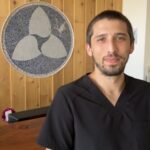Relief from Pain
When you’re in pain, nothing else seems to matter. Our integrative approach to pain management will work to eliminate your pain, increase your function, and get you back to the life you love. At Well Balanced we go straight to the root cause of your symptoms by using our integrated, multi-modality approach. We start with a full body assessment of your symptoms and review your full health history, then develop a treatment plan to help you manage your pain as quickly as possible.
Understanding the difference between acute and chronic pain
Acute Pain
Acute pain usually results from an incident and comes on quickly and as been present for less than 3 months.
- In acute pain, soft tissue, muscles and tendons can be injured and must be assessed and treated to relieve pain.
- In addition, the nervous system has reacted to the stress of pain, and must be assessed and treated.
- Focus is placed on reducing tissue inflammation and allowing the nervous system to relax.
Chronic Pain
Chronic pain is any pain lasting longer than 3 months. It can be constant or come and go in intensity.
- In chronic pain, the soft tissue, muscles and tendons have had time to heal, but the nervous system still perceives injury, as such, needs to be assessed and treated.
- More focus is placed on balancing the nervous system that is “stuck” from the initial incident and increasing tissue and tendon’s ability to handle movement under stress of everyday activities.
Passive and Active Treatments for Integrated Success
Passive treatments allow the body to receive care and allow healing. Active treatments request your participation to learn and practice the daily skills necessary to overcome symptoms. Our integrated success lies in combination of both active and passive treatments in your plan of care.
Passive Treatments
Active Treatments
- Physical Therapy
- Biofeedback
- Home Exercise Program
- Nutrition Therapy
- Herbal Prescription
Practitioners
Sam Horsfall
Massage Therapist
Caitlin Nelson
Massage Therapist
Laura Stice
Acupuncturist & Massage Therapist
Pain conditions effectively addressed using integrative care
- Acute Sprain/Strain
- Arthritis
- Athletic Enhancement
- Baker’s Cyst
- Bursitis
- Carpal Tunnel Syndrome
- Cervical Radiculopathy
- Coccygodynia
- Complex Regional Pain Syndrome (CRPS)
- Costochondritis
- Degenerative Disc/Joint Disease
- De Quervain’s Syndrome
- Facet Joint Syndrome
- Fibromyalgia
- Tension/Stress, Cluster, Sinus, Rebound, Migraine Headaches
- Herniated Discs
- Hip, knee, and shoulder arthritis
- IT Band Friction Syndrome
- Lateral Epicondylitis (Tennis elbow)Lumbar Radiculopathy (Sciatica)
- Medial Epicondylitis (Golfer’s elbow)
- Morton’s Neuroma
- Neuralgia
- Occipital Neuralgia (Arnold’s Neuralgia)
- Paresthesia
- Peripheral Neuropathy
- Piriformis Syndrome
- Plantar Fasciitis/Fibromatosis
- Post Laminectomy Syndrome
- Postural Imbalance
- Reflex Sympathetic Dystrophy (RSD)
- Sacroiliitis/ SI Joint Pain
- Stroke Sequelae
- Surgery rehabilitation
- Rehabilitation from Major Fractures, Hairline and Stress Fractures,Functional Scoliosis
- Shin Splints/ Tibial Stress Syndrome
- Shingles and Post-Herpetic Neuralgia
- Shoulder Impingement/Frozen Shoulder
- Spinal Stenosis, Spondylosis
- Sprained Ligament(s)
- Strained Muscle(s)
- Temporomandibular Joint (TMJ) Pain
- Tendonitis/Tendonopathy
- Tenosynovitis
- Thoracic Outlet Syndrome
- Trigeminal Neuralgia
- Whiplash





